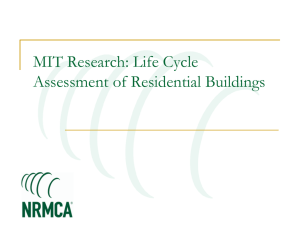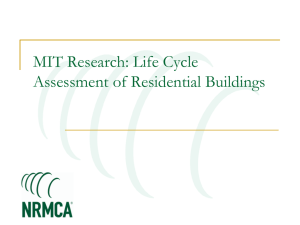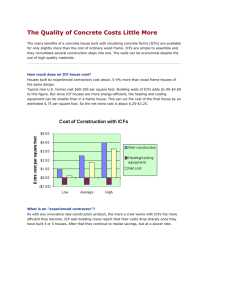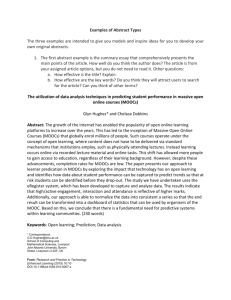SUMMARY REPORT ON COMPARISON OF THE LIFE CYCLE
advertisement
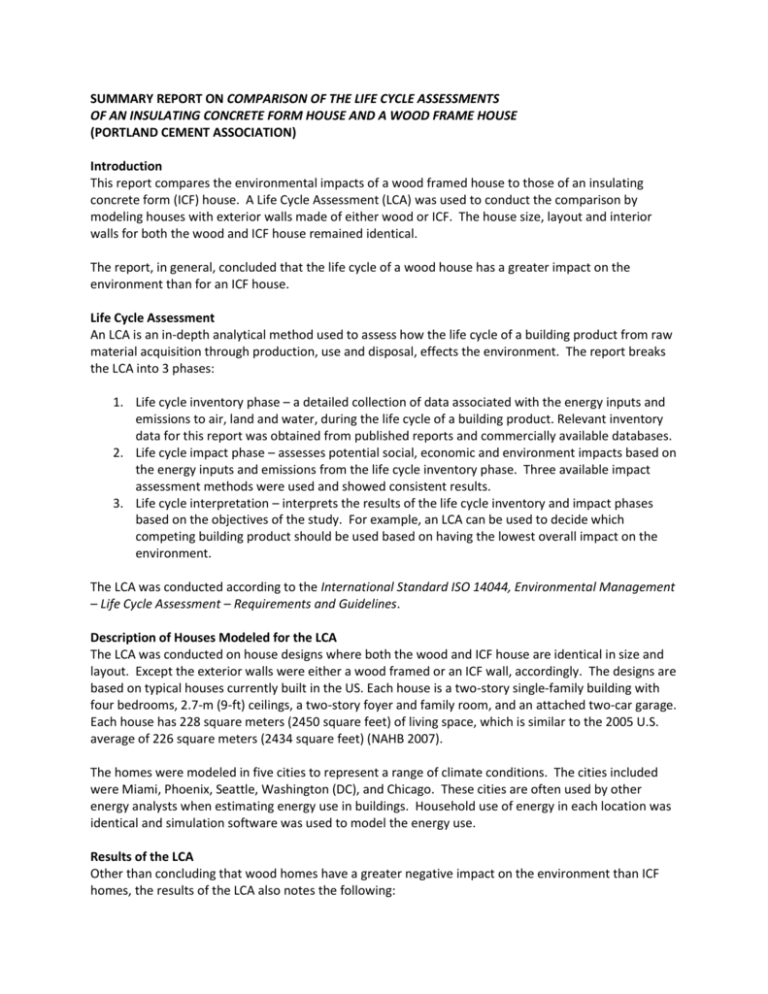
SUMMARY REPORT ON COMPARISON OF THE LIFE CYCLE ASSESSMENTS OF AN INSULATING CONCRETE FORM HOUSE AND A WOOD FRAME HOUSE (PORTLAND CEMENT ASSOCIATION) Introduction This report compares the environmental impacts of a wood framed house to those of an insulating concrete form (ICF) house. A Life Cycle Assessment (LCA) was used to conduct the comparison by modeling houses with exterior walls made of either wood or ICF. The house size, layout and interior walls for both the wood and ICF house remained identical. The report, in general, concluded that the life cycle of a wood house has a greater impact on the environment than for an ICF house. Life Cycle Assessment An LCA is an in-depth analytical method used to assess how the life cycle of a building product from raw material acquisition through production, use and disposal, effects the environment. The report breaks the LCA into 3 phases: 1. Life cycle inventory phase – a detailed collection of data associated with the energy inputs and emissions to air, land and water, during the life cycle of a building product. Relevant inventory data for this report was obtained from published reports and commercially available databases. 2. Life cycle impact phase – assesses potential social, economic and environment impacts based on the energy inputs and emissions from the life cycle inventory phase. Three available impact assessment methods were used and showed consistent results. 3. Life cycle interpretation – interprets the results of the life cycle inventory and impact phases based on the objectives of the study. For example, an LCA can be used to decide which competing building product should be used based on having the lowest overall impact on the environment. The LCA was conducted according to the International Standard ISO 14044, Environmental Management – Life Cycle Assessment – Requirements and Guidelines. Description of Houses Modeled for the LCA The LCA was conducted on house designs where both the wood and ICF house are identical in size and layout. Except the exterior walls were either a wood framed or an ICF wall, accordingly. The designs are based on typical houses currently built in the US. Each house is a two-story single-family building with four bedrooms, 2.7-m (9-ft) ceilings, a two-story foyer and family room, and an attached two-car garage. Each house has 228 square meters (2450 square feet) of living space, which is similar to the 2005 U.S. average of 226 square meters (2434 square feet) (NAHB 2007). The homes were modeled in five cities to represent a range of climate conditions. The cities included were Miami, Phoenix, Seattle, Washington (DC), and Chicago. These cities are often used by other energy analysts when estimating energy use in buildings. Household use of energy in each location was identical and simulation software was used to model the energy use. Results of the LCA Other than concluding that wood homes have a greater negative impact on the environment than ICF homes, the results of the LCA also notes the following: - - - - - In each of the five climates, the ICF houses have lower household energy use than the wood frame houses. The system capacity required for heating, ventilating, and air-conditioning is less for the ICF house than for the wood frame house. The insulation of ICF walls exceeds the International Energy Conservation Code (IECC) requirements by as much as 40 to 500%, depending on climate. Whereas, wood framed walls just meet the IECC requirements. (The IECC is the most widely used residential energy code in the US). The thermal mass of the ICF house moderates temperature swings and peak loads, resulting in lower HVAC system requirements compared to a wood framed house. The ICF house performs better than the wood frame house because of the additional added Rvalue of the insulation and the thermal mass of the concrete. On average, the environmental impact is greater (worse) for the wood house than the ICF house. Largest source of environmental impact on a house is from household use of energy. Approximately 95% of the negative environmental impacts are associated with household use of electricity and natural gas. Similarly, approximately 95% of the life cycle energy use is from household use of electricity and natural gas. Cement manufacturing or concrete production has little effect on the life cycle energy use of a house - less than 0.5% of the life cycle energy use is embodied in the concrete portion of the house. After climate, occupant behavior is the single most important factor contributing to energy consumption in houses. As a result, the house life cycle energy use is a function of climate and occupant behavior, not concrete content. The most significant environmental impacts are not from construction materials but from the production of electricity and natural gas, and the use of electricity and natural gas in the houses by the occupants. For a copy of the report click here.
